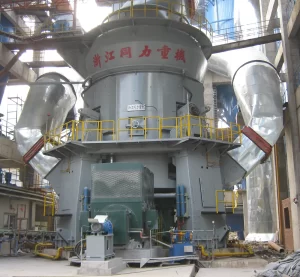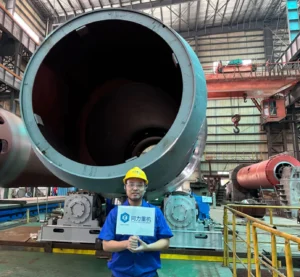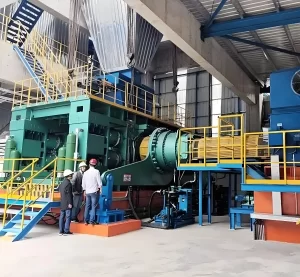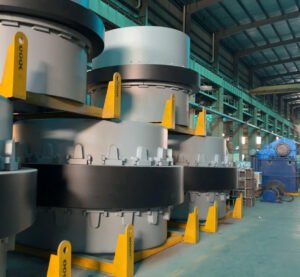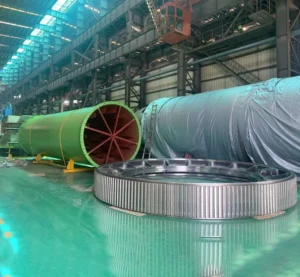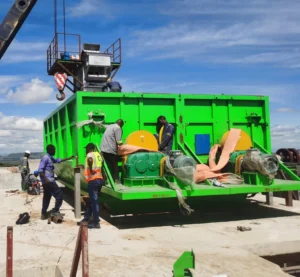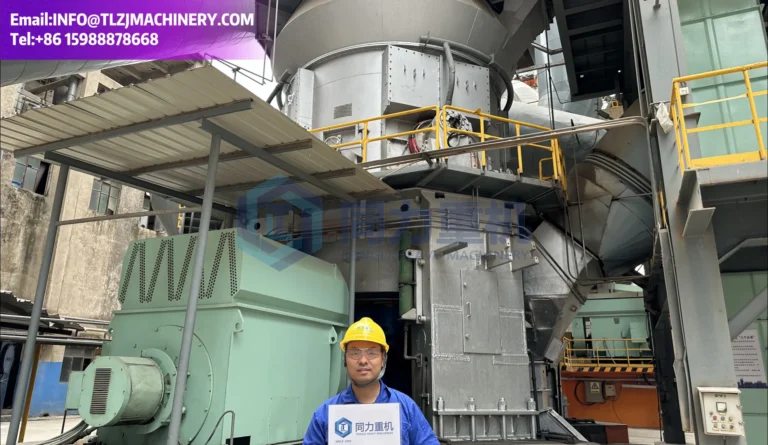TONGLI vertical mill grinding station is a system equipment integrating grinding, classification and transportation. It is mainly composed of vertical mill, classifier, dust collector, transportation equipment, etc.
TONGLI vertical mill grinding station is more and more widely used in modern industry. Its high efficiency, energy saving and environmental protection performance make it popular in cement, slag, coal powder and other industries. Taking a large cement plant as an example, the plant introduced a vertical mill grinding station system with an annual output of 1.2 million tons, which significantly improved production efficiency. Compared with the traditional ball mill system. Its unit power consumption is only 25 kWh/ton, which is 30% lower than the traditional ball mill system. In terms of environmental protection, the dust emission of the grinding station is controlled below 10 mg/m³, which is far lower than the national standard of 30 mg/m³, greatly reducing environmental pollution. In addition, the system is also equipped with an intelligent PLC control system, which realizes the automatic monitoring and adjustment of the entire production process, reducing the error and labor intensity of manual operation. Through data analysis, the production stability of the grinding station has increased by 20%, and the product qualification rate has reached more than 98%.

PRODUCTION LINE EQUIPMENT LIST

Tongli cement vertical mill integrates crushing, drying, grinding, and powder classification. It has high production efficiency and can grind block, granular and powdered cement clinker and other additives into the required powdered materials.
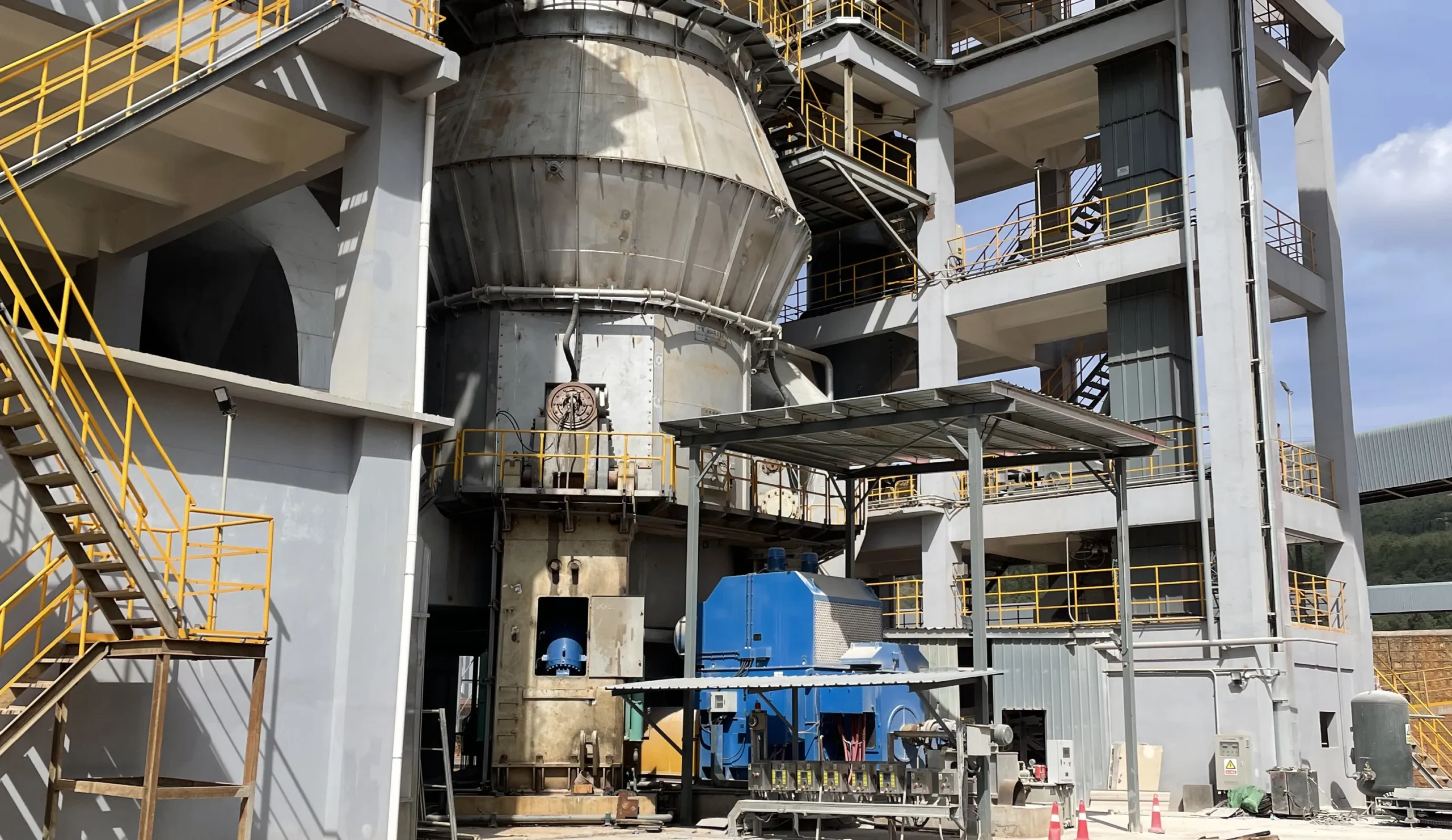
Raw material vertical mill can grind raw materials into powdery materials of required particle size by using roller pressure and grinding shear force through "pressing and grinding" technology.

Coal mill is a kind of equipment specially used for grinding coal powder. It is widely used in industrial production of coal, especially in cement plants to provide fuel for rotary kiln coal powder burner.
NPK PRODUCTION LINE ADVANTAGES
Integrated drying system with integrated drying function is suitable for materials with high water content and improves grinding efficiency.
Low vibration design, special structural design and vibration reduction measures make the equipment run smoothly, reduce vibration and noise.
High-efficiency power transmission system, using the latest reducer and motor combination to ensure efficient power transmission.
Flexible design, can be quickly adjusted to meet the grinding needs of different types of materials, from cement to slag to coal powder.
Ultrafine grinding capacity, equipped with specially designed rollers and grinding discs, can achieve ultrafine grinding.
Wear-resistant materials, rollers and grinding discs are made of high chromium cast iron or ceramic materials.
Dynamic classifier efficiently separates fine powder from coarse particles to improve product quality.
Hydraulic system adjusts roller pressure and controls grinding fineness.
VERTICAL MILL GRINDING PROCESS

Raw Material Preparation
At the beginning of the vertical mill grinding station, raw materials (such as limestone, coal, slag, etc.) are initially crushed from mines, coal yards or other sources, and then transported to the grinding station by trucks or conveyor belts. The raw material silo serves as a storage and buffer to ensure the continuity of the production process. The lower part of the raw material silo is usually equipped with adjustable unloading equipment, such as vibrating feeders or quantitative feeders, to ensure that the materials are evenly transported to the next stage.
Drying Process
For raw materials with high moisture content, such as wet slag or coal, pre-drying treatment is required. Dryers (such as rotary dryers or airflow dryers) use hot air provided by hot air furnaces to evaporate the moisture in the raw materials. The hot air evaporates the moisture quickly through full contact with the material, thereby reducing the moisture content of the material. The dried material enters the feed port of the vertical mill through the hot air conveying pipe.
Grinding Process
The material enters the central grinding disc of the vertical mill through the conveying equipment. The core components of the vertical mill include grinding rollers and grinding discs. Under the action of the hydraulic system, the grinding roller exerts strong pressure on the material, so that the material is crushed into fine powder on the grinding disc. The gap between the grinding roller and the grinding disc can be adjusted according to the grinding requirements of different materials to achieve the required powder fineness. During the rotation of the grinding disc, the material moves outward under the action of centrifugal force, and after multiple crushing and grinding, it finally reaches the required fineness.
Classification Process
The ground fine powder enters the classifier with the airflow, and the classifier is usually located at the top of the vertical mill. The classifier uses rotating blades and airflow to separate qualified fine powder from substandard coarse particles. The centrifugal force generated by the rotating blades throws the coarse particles back to the grinding disc for re-grinding, while the fine powder enters the next link through the outlet of the classifier. The classification accuracy and efficiency of the classifier directly affect the quality of the final product.
Dust Collection Process
The fine powder and airflow coming out of the classifier enter the dust collection system. Bag dust collector is a commonly used dust collection equipment, which captures fine dust through filter bags to ensure that the exhaust gas meets environmental protection standards. When the airflow passes through the filter bag, the dust is captured on the surface of the filter bag, and the clean gas is discharged through the filter bag. The captured powder is sent to the finished product bin through the screw conveyor or air chute at the bottom of the dust collector. In order to keep the filter bag clean and work efficiently, the dust collector is also equipped with a pulse backflush system to regularly clean the dust on the filter bag.
Finished Product Storage
The finished powder after dust collection is sent to the finished product bin through pneumatic conveying or mechanical conveying system. The design of the finished product bin ensures the safety and uniformity of material storage and avoids material stratification and accumulation problems. The finished product bin is usually equipped with automatic unloading equipment to ensure uniform unloading of materials during transportation and packaging. According to production requirements, the finished powder can be transported to the packaging system or directly to the user through pneumatic conveying or screw conveying system.
Automated Control And Monitoring
The entire grinding station is equipped with an advanced PLC automated control system, which realizes real-time monitoring and adjustment of each link such as raw material transportation, drying, grinding, grading, and dust collection through sensors and data acquisition systems. Operators can monitor the equipment operation status through the interface of the central control room and adjust parameters to ensure the continuity and stability of the production process. The automation system can record production data to help optimize the process and improve production efficiency.
Product Quality Inspection
The finished powder needs to be quality inspected before entering the market. Through sampling equipment and online quality monitoring system, the fineness, moisture content, chemical composition and other parameters of the powder are detected to ensure that the product meets the quality standards. The testing equipment can automatically sample and analyze, providing real-time quality data. According to the test results, the operator can adjust the grinding and grading parameters to ensure that the final product meets customer requirements.
Packaging And Transportation
Qualified finished products are packaged by a fully automatic packaging system, generally in bags, ton bags or bulk. The packaging system includes automatic weighing, bagging, sealing and palletizing equipment to ensure that the packaging process is efficient and accurate. The packaged products are sent to the warehouse or directly loaded and transported by conveyor belts or forklifts, ready for sale and use. The design of the packaging system ensures the sealing and stability of the packaging to prevent the product from being damp or contaminated during transportation.
VIDEO
WHY CHOOSE US
The cement production line is efficient, reliable, and provides consistent quality. Customer service and support are excellent. We're highly satisfied and would recommend it.

CFO
The cement production line is efficient, reliable, and provides consistent quality. Customer service and support are excellent. We're highly satisfied and would recommend it.

CEO
The cement production line is efficient, reliable, and provides consistent quality. Customer service and support are excellent. We're highly satisfied and would recommend it.

CEO
The cement production line is efficient, reliable, and provides consistent quality. Customer service and support are excellent. We're highly satisfied and would recommend it.

CEO
FAQ
Vertical mills are mainly used to grind various raw materials, such as cement, raw materials, slag, coal, etc. It crushes materials through the interaction of rotating grinding discs and grinding rollers.
Vertical mills are widely used in the cement industry, especially for large-scale production. Taking grinding cement as an example, the grinding capacity of vertical mills is usually 80-120 tons per hour, and the energy consumption is 20-30% lower than that of traditional ball mills.
In addition, vertical mills are also used for grinding operations in industries such as slag micropowder and non-metallic minerals. Due to its high efficiency, energy saving and low maintenance cost, vertical mills have been widely used in industry.
Vertical mill grinding stations are known for their high efficiency and energy-saving performance. Compared with traditional ball mills, vertical mills usually reduce energy consumption by 30% to 50%. This is because vertical mills use vertical pressure and the rolling action of grinding rollers to make the grinding action of materials more concentrated and effective.
The pressure grinding process used by the vertical mill reduces unnecessary energy waste in the grinding process. At the same time, the compact structure of the vertical mill reduces the material transportation and circulation time, thereby further saving energy consumption.
In addition, the vertical mill also has a higher heat exchange efficiency and can better utilize the heat generated in the process. This not only reduces the operating cost of the equipment, but also reduces the heat emission to the environment. Overall, the vertical mill grinding station has significant advantages in energy saving and is an important choice for pursuing energy efficiency optimization in industrial production.
The requirements of the vertical mill grinding station for raw materials are mainly concentrated in terms of particle size, hardness and moisture. First, the particle size of the raw materials should be controlled within a certain range to ensure grinding efficiency. Too large particles may cause increased mill load and increased wear.
Secondly, the hardness of the raw materials directly affects the selection and wear of the mill. Generally speaking, the vertical mill is suitable for materials with medium and low hardness, and special design or selection of suitable wear materials are required for high hardness materials.
The moisture content of the raw materials is also very critical. Excessive moisture may cause agglomeration inside the mill, affecting material fluidity and mill efficiency. Usually, the moisture content of the material should be controlled between 1% and 2%. By controlling these characteristics of the raw materials, the efficient operation and product quality of the vertical mill grinding station can be guaranteed.
Vertical mill grinding stations are used for grinding a variety of materials due to their wide adaptability. The materials it can process include cement raw materials, cement clinker, slag, coal powder, limestone, etc.
The design of the vertical mill enables it to handle materials of different hardness and humidity. For example, in the cement industry, the vertical mill can effectively grind raw materials and clinker to improve the fineness and quality of cement.
In the steel industry, vertical mills are widely used for slag grinding to enhance its activity by increasing the fineness of slag.
In the power industry, vertical mills are used for coal powder preparation to improve combustion efficiency and reduce emissions. The chemical industry also often uses vertical mills to process various chemical raw materials and optimize the particle size distribution of products. Therefore, the vertical mill grinding station has become an ideal solution for grinding processes in various industries due to its versatility and efficiency.
Preventing wear is the key to ensure the long-term operation of vertical mill grinding station. First, choosing wear-resistant materials is an effective method, such as using high-chromium alloy steel to make grinding rollers and grinding discs.
Secondly, regular wear detection and maintenance, and timely replacement of worn parts to prevent wear expansion and equipment performance degradation. Adjust the pressure between the grinding roller and the grinding disc to maintain appropriate grinding force and reduce excessive wear on the equipment.
The improvement of the lubrication system can also effectively reduce wear. Regular inspection and replenishment of lubricating oil to ensure the smooth operation of all moving parts.
In addition, optimizing operating parameters and avoiding overload operation of equipment are also important means to reduce wear. Through these measures, wear can be significantly reduced and the service life of equipment can be increased.
Coping with raw material changes is one of the challenges in the operation of a vertical mill grinding station. First, the operating parameters of the mill, such as grinding pressure and grinding disc speed, are flexibly adjusted to adapt to the characteristics of different raw materials. The optimal process conditions for different raw materials are determined through experiments to ensure grinding efficiency and product quality.
The efficient grading system can be adjusted in time to ensure that the product particle size meets the requirements. The multifunctional design of the equipment can also handle raw materials of different types and specifications. Through these measures, the vertical mill grinding station can flexibly cope with raw material changes and maintain stable production capacity and product quality.
5000 TPD CEMENT PRODUCTION LINE TECHNICAL PARAMETERS
| Item | Production Capacity (t/h) | Specification | Power | Quantity (Sets) |
| Vertical Mill | 80~120 | Grinding table diameter 3200 mm | 1000 kW | 1 |
| Classifier | 50~80 | Diameter 4000 mm | 45 kW | 1 |
| Bag Filter | - | Capacity 60,000 m³/h | 75 kW | 1 |
| Bucket Elevator | 50~80 | TH800 x 30 m | 30 kW | 1 |
| Belt Conveyor | 50~100 | Width 1200 x 60 m | 22 kW | 1 |
| Automatic Control System | - | PLC Control | - | 1 |
| Hydraulic System | - | Hydraulic Cylinder | 15 kW | 1 |
| Mill Liner | - | High Chromium Alloy | - | - |
| Grinding Roller | - | Tungsten Carbide | - | 3 |
| Powder Separator | 30~60 | Rotor diameter 1600 mm | 55 kW | 1 |

